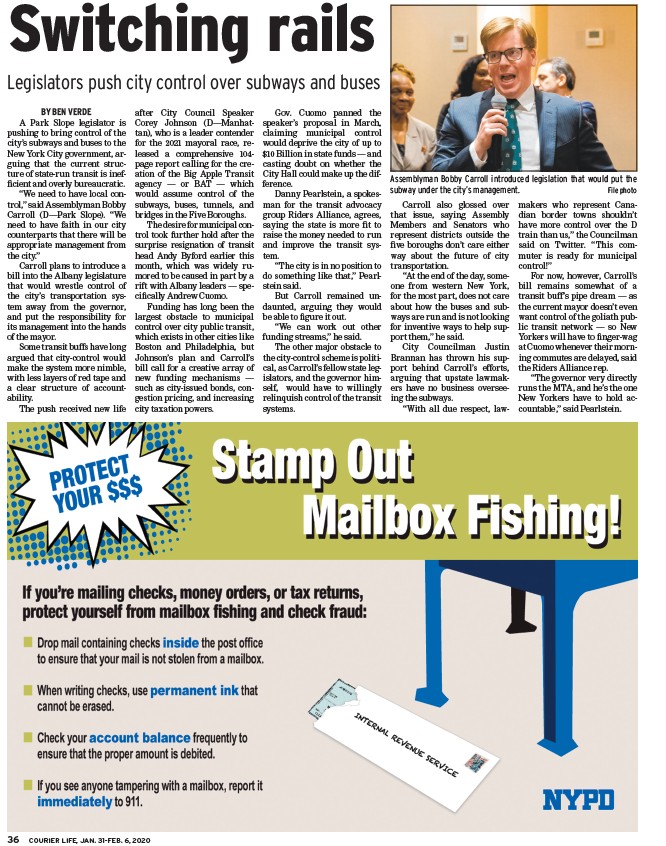
BY BEN VERDE
A Park Slope legislator is
pushing to bring control of the
city’s subways and buses to the
New York City government, arguing
that the current structure
of state-run transit is ineffi
cient and overly bureaucratic.
“We need to have local control,”
said Assemblyman Bobby
Carroll (D—Park Slope). “We
need to have faith in our city
counterparts that there will be
appropriate management from
the city.”
Carroll plans to introduce a
bill into the Albany legislature
that would wrestle control of
the city’s transportation system
away from the governor,
and put the responsibility for
its management into the hands
of the mayor.
Some transit buffs have long
argued that city-control would
make the system more nimble,
with less layers of red tape and
a clear structure of accountability.
The push received new life
after City Council Speaker
Corey Johnson (D—Manhattan),
COURIER L 36 IFE, JAN. 31-FEB. 6, 2020
who is a leader contender
for the 2021 mayoral race, released
a comprehensive 104-
page report calling for the creation
of the Big Apple Transit
agency — or BAT — which
would assume control of the
subways, buses, tunnels, and
bridges in the Five Boroughs.
The desire for municipal control
took further hold after the
surprise resignation of transit
head Andy Byford earlier this
month, which was widely rumored
to be caused in part by a
rift with Albany leaders — specifi
cally Andrew Cuomo.
Funding has long been the
largest obstacle to municipal
control over city public transit,
which exists in other cities like
Boston and Philadelphia, but
Johnson’s plan and Carroll’s
bill call for a creative array of
new funding mechanisms —
such as city-issued bonds, congestion
pricing, and increasing
city taxation powers.
Gov. Cuomo panned the
speaker’s proposal in March,
claiming municipal control
would deprive the city of up to
$10 Billion in state funds — and
casting doubt on whether the
City Hall could make up the difference.
Danny Pearlstein, a spokesman
for the transit advocacy
group Riders Alliance, agrees,
saying the state is more fi t to
raise the money needed to run
and improve the transit system.
“The city is in no position to
do something like that,” Pearlstein
said.
But Carroll remained undaunted,
arguing they would
be able to fi gure it out.
“We can work out other
funding streams,” he said.
The other major obstacle to
the city-control scheme is political,
as Carroll’s fellow state legislators,
and the governor himself,
would have to willingly
relinquish control of the transit
systems.
Carroll also glossed over
that issue, saying Assembly
Members and Senators who
represent districts outside the
fi ve boroughs don’t care either
way about the future of city
transportation.
“At the end of the day, someone
from western New York,
for the most part, does not care
about how the buses and subways
are run and is not looking
for inventive ways to help support
them,” he said.
City Councilman Justin
Brannan has thrown his support
behind Carroll’s efforts,
arguing that upstate lawmakers
have no business overseeing
the subways.
“With all due respect, lawmakers
who represent Canadian
border towns shouldn’t
have more control over the D
train than us,” the Councilman
said on Twitter. “This commuter
is ready for municipal
control!”
For now, however, Carroll’s
bill remains somewhat of a
transit buff’s pipe dream — as
the current mayor doesn’t even
want control of the goliath public
transit network — so New
Yorkers will have to fi nger-wag
at Cuomo whenever their morning
commutes are delayed, said
the Riders Alliance rep.
“The governor very directly
runs the MTA, and he’s the one
New Yorkers have to hold accountable,”
said Pearlstein.
Switching rails
Legislators push city control over subways and buses
Assemblyman Bobby Carroll introduced legislation that would put the
subway under the city’s management. File photo